Team:
Jorge Morales, Tian Yuanpei & Michael Salka
Brief 1:
Design one 3d piece of furniture (real human scale) made out of 20 panels of 3 – 4 mm thick corrugated cardboard measuring 900 mm x 600 mm to be cut using the LaserPro Spirit GE. The final furniture will be tested for real application and rigidity by IaaC staff.
Intent:
To leverage a structural system other than waffling.
To produce a proper chair for chilling! We need to rest after we work.
Mantra:
“Chairs are architecture, sofas are bourgeois…” – Le Corbusier
Inspiration:
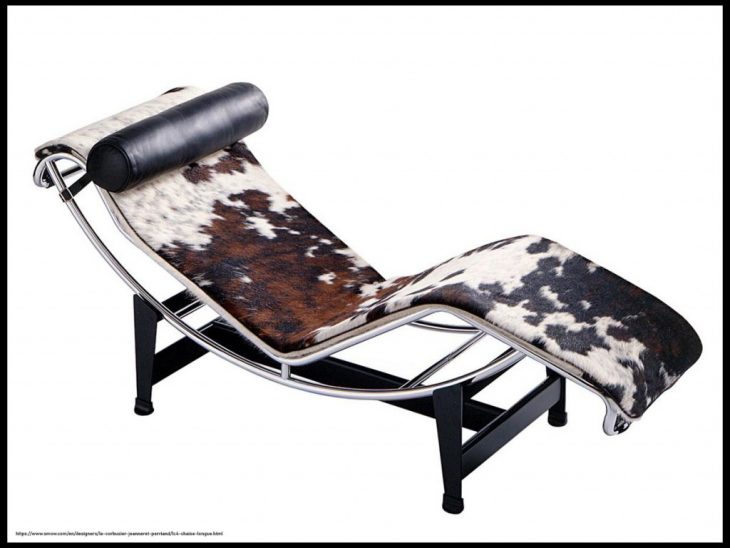
https://www.smow.com/en/designers/le-corbusier-jeanneret-perriand/lc4-chaise-longue.html
Rationale:
Valldaura has ample furniture for working, but is in dire need of fixtures for relaxation. Further, we sought to maintain the long-running obsession architects have for chairs as an ideal medium for expressing theories of human habitation.
The radiused rails, apart from allowing for pleasant rocking, are an elegant technique for enabling adaptation of the seating angle.
Cardboard is generally considered a utilitarian material, thus we sought to flaunt expectations by converting the stock into as comfortable a form as possible.
Process:
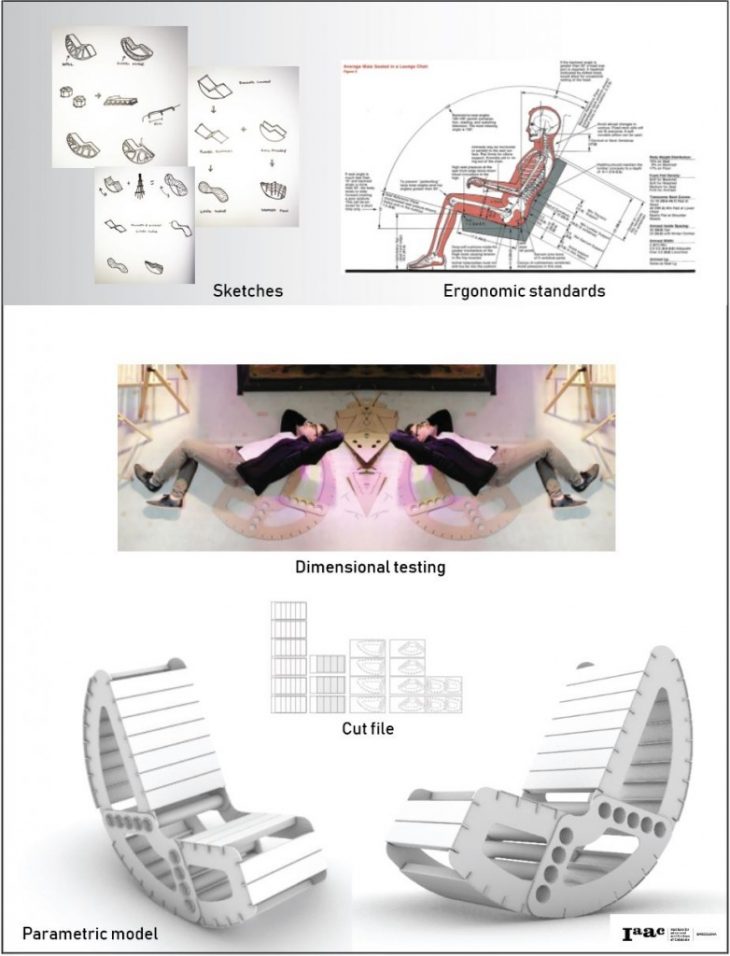
Sketches, Ergonomic Diagram, Dimensional Testing, Cut File & Parametric Model
Results:
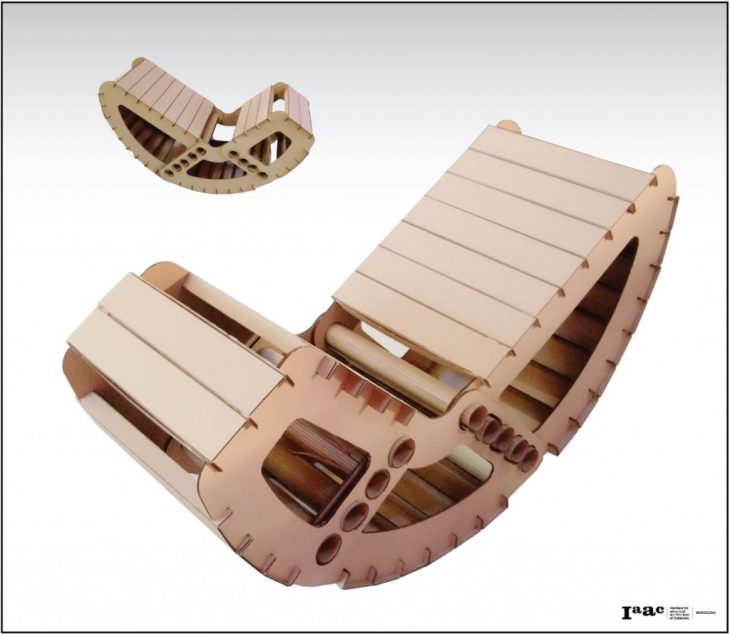
Laser Cut Prototype
Lessons:
Avoiding waffle structures is easier said than done.
For this design to be fully functional additional internal supports are required.
Some creativity is needed to design pieces larger than the laser cutter bed, particulary with regard to joinery if it is to be realized without other materials.
Notching scripts must be adapted to vary the width depending on the number of pieces to be inserted (i.e. at ends of planking runs).
Brief 2:
Design a 3D printed lamp for the Valldaura workshop space, reduce material usage and waste while maximizing the build volume and aesthetics.
Intent:
To propose solutions which can only be produced via 3D printing.
To propose solutions which are produced much more efficiently via 3D printing than any other method.
To produce solutions which test the capacities of the available 3D printing hardware and software.
Mantra:
“Failure is simply the opportunity to begin again, this time more intelligently” – Henry Ford
Inspiration:
Rationale:
‘Non-orientable’ objects like the Möbius Strip or Klein Bottle are naturally aesthetic due to their ability to present observers with physical realities which intuition deem impossible.
Similar to how the more familiar Möbius Strip turns a two-sided plane into a one-edged, one-sided object by twisting and looping, the Klein Bottle passes through itself to create an object with a single continuous surface having no inside nor outside. The resulting ‘minimal’ shell is thus inherently materially efficient.
Apart from being an intruiging paradox, these characteristics make such objects difficult to fabricate; historically, the Möbius Strip and Klein Bottle could only be manufactured with flexible but fragile materials like paper, or materials which require a high-degree of specialized training to manipulate, such as glass.
Given their layered (sliced) additive process, 3D printers are able to mitigate these difficulties by eliminating the need for any twisting, seaming or puncturing, for the first time making such objects readily producable in durable materials by makers with relatively little skill or expertise.
Process:
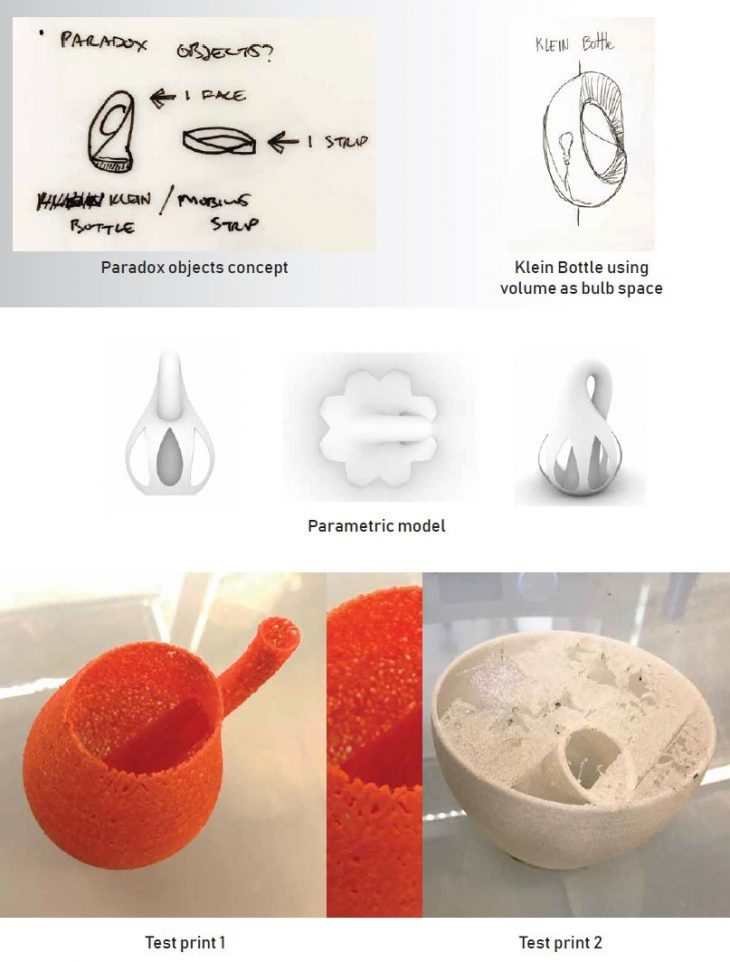
Sketches, Parametric Model & Test Prints
Results:
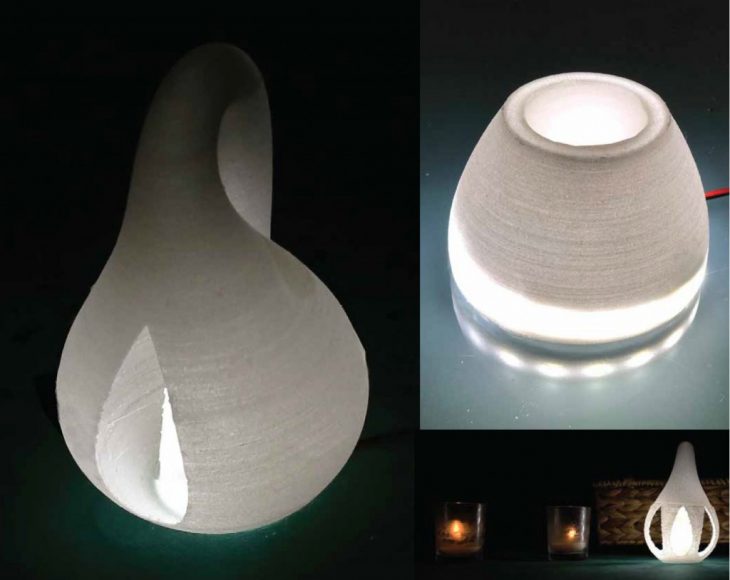
Final Lamp Series
Lessons:
Cantilevers must be designed appropriately to achieve successful printing without supports.
By topologic definition, non-orientable surfaces do not have consistent normal vectors, therefore offsetting to create thickness does not produce water-tight geometries.
ABS is able to generate quality surfaces at much faster print speeds than PLA.
Each successive layer of printing further refracts light, thus even transparent filament can create at best only translucent objects.
Initial build plate adhesion is essential.
Brief 3:
Design a 3D printed structural node to use with bamboo sticks, maximizing strength and minimizing material usage.
Intent:
To propose solutions which can only be produced via 3D printing.
To propose solutions which are produced much more efficiently via 3D printing than any other method.
To produce solutions which test the capacities of the available 3D printing hardware and software.
Mantra:
“Failure is simply the opportunity to begin again, this time more intelligently” – Henry Ford
Inspiration:
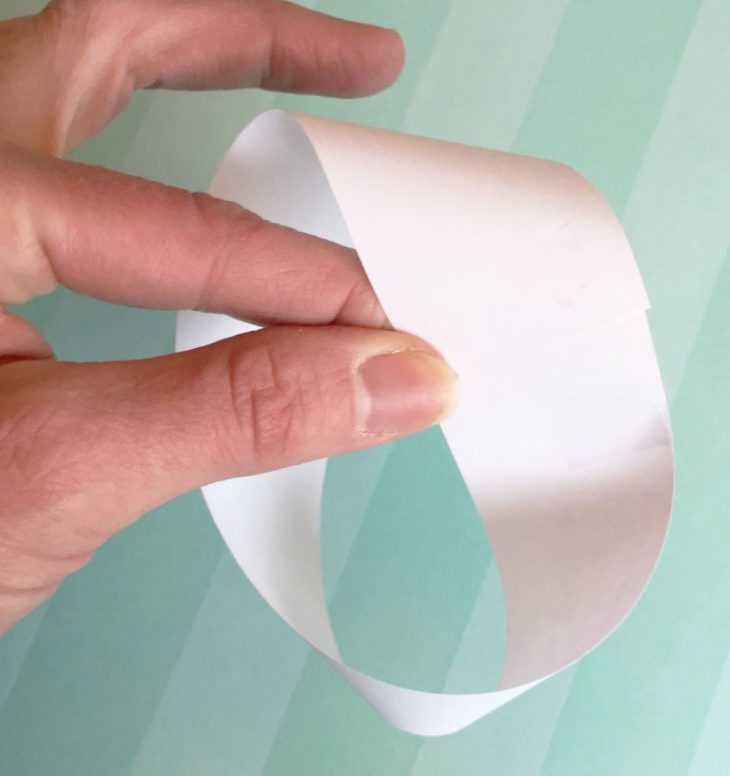
Mobius Strip
Rationale:
Non-orientable surfaces like the Möbius Strip or Klein Bottle are naturally aesthetic objects due to their ability to present observers with geometric realities which intuition deem impossible.
The Möbius Strip turns a two-sided plane into a one-edged, one-sided object by twisting and looping. The resulting ‘minimal’ structure is thus inherently materially efficient. Further, it can be made into an adaptable joint by simply adjusting the number of twists with respect to the number of elements to be passed through the interior space in oppossing directions.
Apart from being an intruiging paradox, these characteristics make such objects difficult to fabricate; historically, the Möbius Strip and Klein Bottle could only be manufactured with flexible but fragile materials like paper, or materials which require a high-degree of specialized training to manipulate, such as glass.
Given their layered (sliced) additive process, 3D printers are able to mitigate these difficulties by eliminating the need for any twisting or seaming, for the first time making such objects readily producable in durable materials by makers with relatively little skill or expertise.
Process:

Sketches, Parametric Model & Test Print
Results:
Final Joint
Lessons:
Cantilevers must be designed appropriately to achieve successful printing without supports.
By topologic definition, non-orientable surfaces do not have consistent normal vectors, therefore offsetting to creat thickness does not produce water-tight geometries.
ABS is able to print much faster than PLA.
Möbius Strip can be modeled in Rhino by projecting a twisted plane along a closed curve, but plug-ins exist which perform the operation and offer greater parametric control.
Brief 4:
Design one 3d piece of furniture (real human scale) made out of 2 panels of 15 mm thick pine plywood mesuring 2440 mm x 1220 mm, final furniture will be tested for real application and rigidity by IaaC staff.
Intent:
To leverage a structural system other than waffling.
To directly compare material and tooling charactersitcs by creating similar forms using either laser cutting or CNC milling.
To produce a proper chair for chilling! We need to rest after we work.
Mantra:
“Chairs are architecture, sofas are bourgeois…” – Le Corbusier
Inspiration:

https://www.smow.com/en/designers/le-corbusier-jeanneret-perriand/lc4-chaise-longue.html
Rationale:
Valldaura has ample furniture for working, but is in dire need of fixtures for relaxation. Further, we sought to maintain the long-running obsession architects have for chairs as an ideal medium for expressing theories of human habitation.
The radiused rails, apart from allowing for pleasant rocking, are an elegant technique for enabling adaptation of the seating angle.
By manufacturing two chairs with nearly identical form and function using either laser cut cardboard or CNC milled plywood, we aimed to directly compare and contrast the advantages and limitations of each method and material employed.
Process:
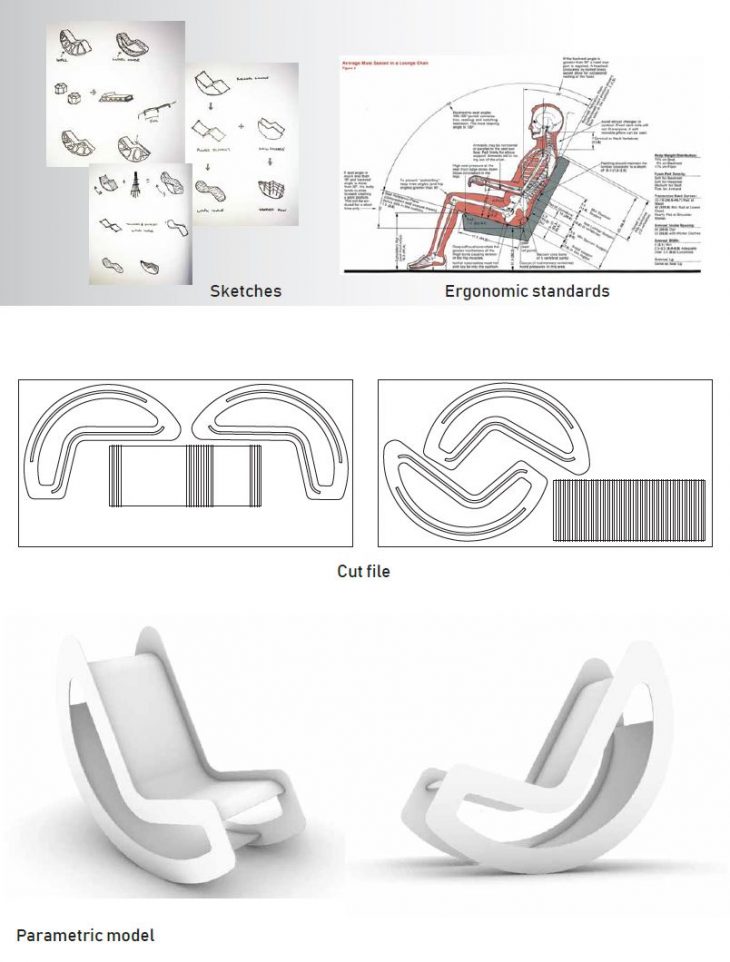
Sketches, Ergonomic Diagram, Cut Files & Parametric Model
Results:
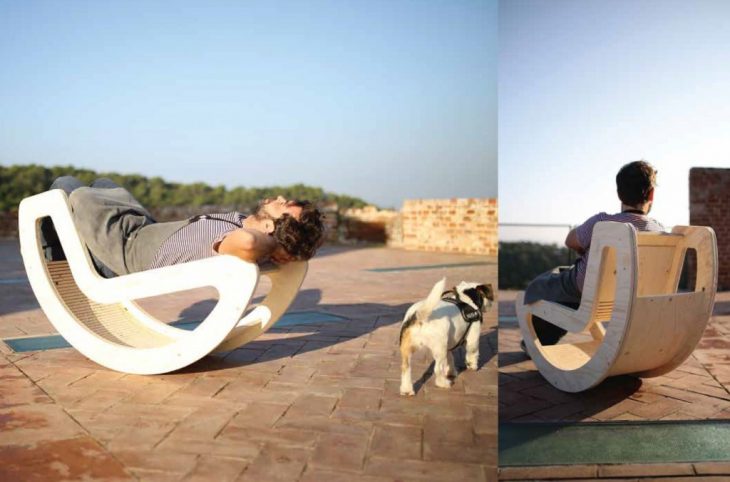
Final Lounge
Lessons:
Avoiding waffle structures is easier when CNC milling plywood than when laser cutting cardboard.
For kerf bends to be effective, sufficient lengths of wood must be left on eithr side of the radius to act as levers when performing the bend. The kerf must also be deep enough that the thinnest layer possible needed to maintain structural integrity remains. Soaking the wood with hot water or steam prior to bending is imperative as well.
When working with wood joinery tolerances are critical. This is especially true when the wood to be joined is bent in a curve.
The Laser Cut Cardboard Lounge, 3D Printed Klein Bottle Lamp & 3D Printed Mobius Strip Bamboo Joint are projects of IaaC, Institute for Advanced Architecture of Catalonia developed at the Master of Advanced Ecological Buildings in 2018 by:
Students: Jorge Morales, Tian Yuanpei & Michael Salka
Faculty: Eduardo Chamorro
